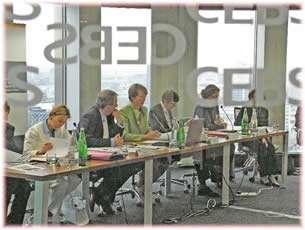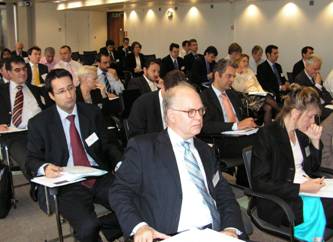CEBS publishes a summary of the open hearing on large exposures
On 15 June 2007, the Committee of European Banking Supervisors (CEBS) submitted for public consultation its initial views on key basic concepts of a large exposures regime in the EU as part of its response to the first part of the European Commission's second call for advice. In the context of the ‘Better Regulation' agenda, CEBS also put forward some preliminary results from its market and regulatory failure analyses. CP14 is available at (CP14) As part of this consultation, CEBS organised a hearing open to all interested parties on 11 July 2007 in London.

The objectives of the event were to hear about the range of market participants' views on CEBS' proposals, coming from large sophisticated institutions as well as from smaller or less sophisticated institutions, and to receive input from them on key technical issues identified in the Consultative Paper.

(Kerstin af Jochnick, Chair of EGCR and
Jesús Ibáñez, Chair of the Subgroup on
Large Exposures)
The views expressed on the paper were in general fairly positive notwithstanding the comments and suggestions on specific matters and the fact that the final assessment will largely depend on the forthcoming advice on the second part of the Commission Call for Advice.
A large exposures regime as a back stop against unforeseen and traumatic losses
The main focus of the discussion was on the purpose and objective of a large exposures regime now that the new Capital Adequacy Regime is in place.
Some participants pointed out that the current regime is disconnected from the internal concentration risk management practices of institutions, at least from the larger and sophisticated ones.
One participant indicated that one should not presuppose a regulatory outcome of the review.
Participants were generally of the view that a large exposures regime is helpful if its serves as a backstop against unforeseen event risk i.e. the risk that an idiosyncratic event – typically beyond the parameters of regulatory or economic capital models – causes the sudden default of an exposure, and thereby causing a traumatic loss at an institution.
With this objective clearly set out, a large exposure regime would not overlap the risk-sensitive regime introduced by the Capital Requirements Directive with its incentives for institutions to improve their management of concentration risk.
A regime that is simple, relevant, and closely aligned with the institutions' systems for the measurement and assessment of exposure values
Representatives of small and less sophisticated institutions said that most of their members rely on the regulatory regime for their internal measurement and management of large exposures. They also invited CEBS to clarify the relationship between a back stop regime and the Pillar 2 requirements on concentration risk for smaller banks.
Representatives of the larger and more sophisticated institutions indicated that the current regulatory limit system is additional to internal processes but is generally not considered to be costly. In particular, the 25% limit appears to be relevant but the 800% limit was questioned.
Participants agreed that it was not appropriate to take into account the credit worthiness of an exposure in a back stop regime, although it forms part of many institutions' internal risk assessment.

Participants invited CEBS to design a regime that is simple, relevant for senior management of an institution, and aligned with institutions' internal measurement systems for estimating exposure values (exposures at default). In particular, and recognising that Basel II and the large exposures regime do not share the same objectives, participants commented that supervisors should rely as much as possible on institutions' internal models as validated in the context of the Capital Requirements Directive. This would contribute to the reduction of the computing and reporting burden of institutions.
With regard to the conversion factors for the calculation of exposure values, participants underlined the competitive issue while recognising that convergence may be difficult to achieve.
Other issues
With regard to collective investment undertakings and structured products, participants asked for the proposed ‘materiality' criterion to be reconsidered with a view to make it simpler and easier to put in place. They were invited to provide in their written submissions some examples of good practice that could be considered by CEBS.
Some participants felt that EU institutions are currently experiencing a competitive disadvantage against third country institutions, notably with regard to the types of exposures exempted in some of those countries. These participants will provide CEBS with additional justification on those gaps.
Some participants invited CEBS to consider specific exemptions from the regime, such as exposures to sovereigns, Central Banks and short-term exposures to highly rated borrowers. Others said there is a need for a regime that is consistently applied by all the 27 Member States. Participants are looking forward to CEBS views on critical issues such as credit risk mitigation and intra-group exposures which are to be covered in the second part of CEBS' advice.
Market failure, regulatory failure and cost benefit analyses
Participants welcomed CEBS' efforts to carry out these analyses as part of the Better Regulation agenda. They however encouraged CEBS to undertake further work to develop further the analyses.
They emphasised that the examples put forward in the document are more closely related to ‘bad governance' rather than a ‘market failure' as such. Although regulatory tools already exist to address such ‘bad governance' issues, some participants were of the opinion that the existence of a backstop regime is nonetheless useful in this respect. They also indicated that no strong evidence was put forward to demonstrate that the objectives of institutions and the regulatory objectives are significantly different. Participants were invited to suggest concrete proposals in their written submissions on ways to improve these analyses.
Time table
Some participants noted that undertaking work to consider an amended large exposures regime at this point in time is inconvenient as the institutions are currently implementing the Capital Requirements Directive. The European Commission Representative present at the hearing indicated that the timetable for submitting a proposal to the European Parliament and the Council had been delayed from end 2007 to end 2008. Prior to that submission, The Commission expects to consult publicly on a draft proposal in early summer 2008. In parallel, the Commission will conduct an impact assessment.
Participants were invited to submit their written contributions no later than 15 August 2007 to cp14@c-ebs.org
Press contacts
Franca Rosa Congiu
